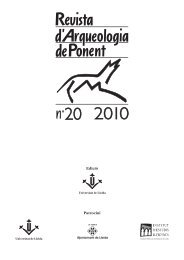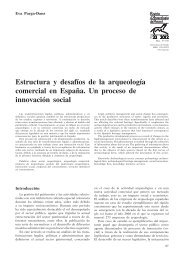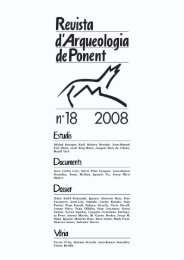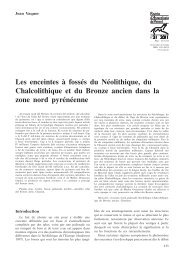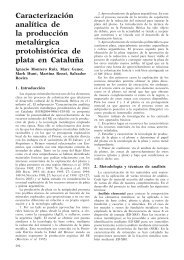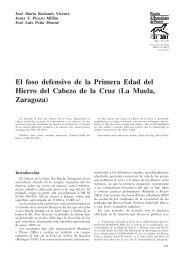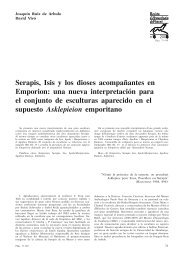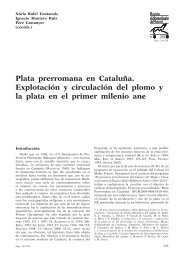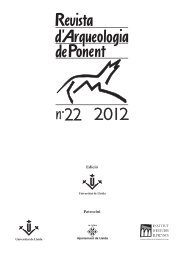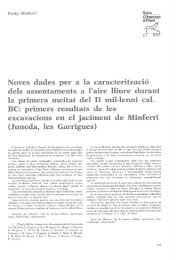El valor social i comercial de la vaixella metàl·lica al Mediterrani ...
El valor social i comercial de la vaixella metàl·lica al Mediterrani ...
El valor social i comercial de la vaixella metàl·lica al Mediterrani ...
You also want an ePaper? Increase the reach of your titles
YUMPU automatically turns print PDFs into web optimized ePapers that Google loves.
vaso si spiega con il <strong>v<strong>al</strong>or</strong>e che gli è attribuito sin<br />
d<strong>al</strong>l’origine: in Assiria esso è legato strettamente <strong>al</strong><strong>la</strong><br />
funzione politica e soprattutto religiosa <strong>de</strong>l re e di<br />
dignitari di <strong>al</strong>tissimo rango, come documentano gli<br />
esemp<strong>la</strong>ri raffigurati nelle scene di libagione di Assurnasirp<strong>al</strong><br />
II (883-859 a.C.) nei rilievi <strong>de</strong>l Pa<strong>la</strong>zzo NW<br />
di Nimrud, o quelli d’oro rinvenuti nelle sepolture<br />
<strong>de</strong>lle regine di Tig<strong>la</strong>th-pileser III (744-727 a.C.) e<br />
Sh<strong>al</strong>manaser V (726-722 a.C.), o ancora <strong>la</strong> patera in<br />
mano <strong>al</strong><strong>la</strong> regina nel celebre rilievo di Niniveh con<br />
Assurbanip<strong>al</strong> a banchetto (668-631 a.C.). 196<br />
In <strong>al</strong>tra se<strong>de</strong> ho attribuito l’introduzione nell’It<strong>al</strong>ia<br />
tirrenica costiera di oggetti di prestigio assiri ed<br />
urartei ad agenti inviati dai sarim, i “principi” <strong>de</strong>lle<br />
oligarchie <strong>de</strong>lle città fenicie. Proprio tra l’ultimo terzo<br />
<strong>de</strong>ll’VIII e gli inizi <strong>de</strong>l VII sec. a.C., con il crollo <strong>de</strong>gli<br />
stati aramaici e neo-ittiti, Tiro assume il ruolo di<br />
princip<strong>al</strong>e fornitore di met<strong>al</strong>li <strong>de</strong>ll’impero assiro: <strong>la</strong><br />
rete <strong>de</strong>i mercanti fenici, già s<strong>al</strong>damente impiantata nel<br />
Mediterraneo occi<strong>de</strong>nt<strong>al</strong>e, viene a compren<strong>de</strong>re in forma<br />
stabile le coste <strong>de</strong>ll’It<strong>al</strong>ia tirrenica. 197 La presenza in un<br />
limitato numero di tombe di eccezion<strong>al</strong>e prestigio di<br />
vasi di lontana provenienza medio-orient<strong>al</strong>e, carichi di<br />
un forte <strong>v<strong>al</strong>or</strong>e simbolico associato <strong>al</strong> potere politico<br />
e religioso, spinge ad interpretare queste importazioni<br />
come “doni di apertura” da parte <strong>de</strong>gli agenti <strong>de</strong>lle<br />
oligarchie fenicie, <strong>al</strong> fine di stabilire re<strong>la</strong>zioni economiche<br />
durature con i potentati etrusco-<strong>la</strong>zi<strong>al</strong>i che<br />
control<strong>la</strong>vano le risorse loc<strong>al</strong>i. Doni <strong>de</strong>gni di re, che<br />
implicano il riconoscimento, da parte di soggetti politici<br />
esterni, <strong>de</strong>l<strong>la</strong> condizione <strong>soci<strong>al</strong></strong>e superiore di <strong>al</strong>cune<br />
gentes etrusco-it<strong>al</strong>iche <strong>al</strong>l’interno <strong>de</strong>l proprio gruppo.<br />
Non diversamente va interpretato il coevo rhyton in<br />
bronzo a protome di leone rinvenuto a Veio Cas<strong>al</strong>e<br />
<strong>de</strong>l Fosso, che si inserisce in un limitato gruppo di<br />
esemp<strong>la</strong>ri assiri attestati a Gordion e Samos e sui<br />
rilievi di Khorsabad. 198<br />
Nel secondo quarto <strong>de</strong>l VII sec. a.C. si assiste <strong>al</strong><strong>la</strong><br />
massima esibizione di ricchezza in <strong>al</strong>cune sepolture<br />
<strong>de</strong>ll’It<strong>al</strong>ia centro-meridion<strong>al</strong>e. Benché nei centri maggiori<br />
molte tombe possano aspirare, per l’abbondanza<br />
<strong>de</strong>l corredo, <strong>al</strong> rango di sepoltura “aristocratica”, <strong>al</strong>cune<br />
di esse spiccano non solo per il lusso complessivo,<br />
ma anche per <strong>la</strong> presenza di oggetti eccezion<strong>al</strong>i che<br />
assumono significati di partico<strong>la</strong>re rilevanza.<br />
Basti pensare ai due c<strong>al</strong><strong>de</strong>roni con protomi e<br />
sostegni tronco-conici <strong>de</strong>corati a sb<strong>al</strong>zo d<strong>al</strong>le Tombe<br />
Barberini e Bernardini di Preneste. 199 Sono noti so<strong>la</strong>mente<br />
<strong>al</strong>tri cinque esemp<strong>la</strong>ri simili, tutti da Olimpia,<br />
prodotti da una stessa bottega di artisti nord-siriani,<br />
operante tra <strong>la</strong> fine <strong>de</strong>ll’VIII e gli inizi <strong>de</strong>l VII sec.<br />
a.C.), sono probabilmente da ascrivere, nonostante il pessimo<br />
stato di conservazione, ad una produzione fenicia su mo<strong>de</strong>lli<br />
assiri piuttosto che direttamente medio-orient<strong>al</strong>e (IBID.: 348).<br />
196. SCIACCA 2005, 30ss., 239ss.<br />
197. Data <strong>la</strong> vastità <strong>de</strong>l tema e <strong>de</strong>l<strong>la</strong> re<strong>la</strong>tiva bibl. si rimanda<br />
a SCIACCA 2005, 395-422.<br />
198. SCIACCA 2003b; DRAGO 2005, 111ss. MUSCARELLA (1992:<br />
41s.; 1998: 155ss.) ha interpretato le poche ma significative<br />
importazioni di prestigio d<strong>al</strong>l’Assiria <strong>al</strong><strong>la</strong> Frigia (e viceversa),<br />
tra cui i celebri rhyta in bronzo a protome di leone e di ariete<br />
d<strong>al</strong> Tumulo MM di Gordion, come doni diplomatici atti<br />
a suggel<strong>la</strong>re <strong>la</strong> momentanea <strong>al</strong>leanza tra Mida e Sargon II,<br />
testimoniata d<strong>al</strong>le fonti nel 709 a.C.<br />
199. CANCIANI, VON HASE 1979, 46ss., n. 42, tav. 27ss.<br />
a.C. 200 L’eccezion<strong>al</strong>e presenza a Praeneste di questi<br />
due capo<strong>la</strong>vori <strong>de</strong>l<strong>la</strong> toreutica antica suggerisce anche<br />
in questo caso <strong>la</strong> loro natura di doni (non sappiamo<br />
se da parte di greci o di orient<strong>al</strong>i) ai personaggi più<br />
eminenti <strong>de</strong>l<strong>la</strong> città <strong>la</strong>tina 201 . Che si ritenesse adatto<br />
ad un personaggio re<strong>al</strong>e ciò che in Grecia era<br />
pertinente <strong>al</strong>le massime divinità <strong>de</strong>l pantheon non<br />
sorpren<strong>de</strong> rispetto <strong>al</strong>l’organizzazione religiosa etrusco<strong>la</strong>zi<strong>al</strong>e<br />
<strong>de</strong>ll’Orient<strong>al</strong>izzante antico e medio, fortemente<br />
incentrata sul potere <strong>de</strong>ll’autorità politica di far da<br />
tramite con <strong>la</strong> divinità, come traspare da personaggi<br />
letterari come Numa Pompilio. 202<br />
La produzione <strong>de</strong>lle coppe in argento dorato con<br />
scene militari d<strong>al</strong>le stesse tombe di Praeneste e d<strong>al</strong><strong>la</strong><br />
T. Regolini-Ga<strong>la</strong>ssi di Cerveteri è stata ricondotta da<br />
<strong>al</strong>cuni studiosi ad una singo<strong>la</strong> bottega di artisti fenici<br />
immigrati in It<strong>al</strong>ia (probabilmente a Cerveteri), 203 oppure<br />
operanti in Fenicia o a Cipro secondo <strong>al</strong>tri. 204 La<br />
re<strong>al</strong>izzazione di un nuovo disegno <strong>de</strong>l<strong>la</strong> patera 13205<br />
d<strong>al</strong><strong>la</strong> T. Barberini (fig. 3), 205 in argento dorato, ed un<br />
confronto autoptico con gli <strong>al</strong>tri esemp<strong>la</strong>ri permette,<br />
per quanto sinteticamente, un passo ulteriore nel<strong>la</strong><br />
<strong>de</strong>finizione <strong>de</strong>l gruppo. Il trattamento stilistico <strong>de</strong>i<br />
fanti, <strong>de</strong>i cav<strong>al</strong>li con cav<strong>al</strong>ieri, <strong>de</strong>gli uccelli e <strong>de</strong>gli<br />
<strong>al</strong>beri-cipresso <strong>de</strong>l<strong>la</strong> patera Barberini è i<strong>de</strong>ntico a quello<br />
nelle patere <strong>de</strong>l<strong>la</strong> T. Regolini-Ga<strong>la</strong>ssi 20364 (fig. 4), 206<br />
200. HERRMANN 1966a, 180ss.; GEHRIG 2004, 89ss., 323s., con<br />
bibl. (per le protomi).<br />
201. Non è da esclu<strong>de</strong>re, nel caso di Praeneste, che si tratti<br />
di un dono diretto, senza l’intermediazione di un centro costiero<br />
come Cerveteri. Qui l’unico oggetto <strong>de</strong>l<strong>la</strong> stessa tipologia <strong>de</strong>i<br />
c<strong>al</strong><strong>de</strong>roni in esame, l’esemp<strong>la</strong>re in bronzo d<strong>al</strong><strong>la</strong> Tomba Regolini-Ga<strong>la</strong>ssi<br />
(PARETI 1947, 304s., n 303, tav. XXXIX), molto più<br />
semplice per forma e <strong>de</strong>corazione, è opera di un artigiano<br />
fenicio immigrato ed ha un carattere chiaramente imitativo<br />
rispetto <strong>al</strong>le importazioni <strong>de</strong>lle tombe prenestine. L’ipotesi di<br />
contatti diretti con orient<strong>al</strong>i senza <strong>la</strong> mediazione di <strong>al</strong>tri centri<br />
etruschi è <strong>de</strong>l resto rafforzata d<strong>al</strong><strong>la</strong> presenza nel<strong>la</strong> T. Bernardini<br />
di <strong>al</strong>tre importazioni orient<strong>al</strong>i che non hanno <strong>al</strong>tre attestazioni<br />
nel<strong>la</strong> Peniso<strong>la</strong>, come ad esempio il piccolo lebete con colino<br />
e attingitoio in argento (da ultimo BOTTO 2004a, 180ss.) e il<br />
manico in bronzo rivestito d’argento con e<strong>la</strong>borate scene di lotta<br />
tra figure umane o divinità e mostri (CANCIANI, VON HASE 1979,<br />
42s., n. 34, tavv. 21s.), sul cui <strong>la</strong>to interno è stata applicata in<br />
un secondo momento, da un artigiano loc<strong>al</strong>e, una <strong>la</strong>mina con<br />
file di anim<strong>al</strong>i a sb<strong>al</strong>zo.<br />
202. Sul legame tra Tinia e personaggi aristocratici re<strong>al</strong>i cfr.<br />
le ipotesi formu<strong>la</strong>te in SCIACCA 2004.<br />
203. HOPKINS 1965, 202; CULICAN 1982, 27; MARKOE 1985, 147;<br />
NERI 2000, 29; MARKOE 2003, 214; BOTTO 2004b, 32s.<br />
204. GJERSTAD 1946, 18; STRØM 1971, 123; CANCIANI, VON HASE<br />
1979, 5s.; RATHJE 1980, 16ss.; CRISTOFANI, MARTELLI 1983, 42s.,<br />
256s.; BURANELLI, SANNIBALE 2006, 220.<br />
205. Sono grato <strong>al</strong><strong>la</strong> D.ssa Boitani, Direttrice <strong>de</strong>l Museo<br />
Nazion<strong>al</strong>e di Vil<strong>la</strong> Giulia, per l’autorizzazione <strong>al</strong>lo studio <strong>de</strong>l<br />
vaso.<br />
206. PARETI 1947, 313s., n. 322; RATHJE 1980, B 9, 10, fig. 16;<br />
MARKOE 1985, E 8, 197; BURANELLI, SANNIBALE 1998, 424ss., n.<br />
235, figg. 262s.; EID. in REE 54, 2001, 357ss., n. 29 e EID. 2006,<br />
con rinvenimento <strong>de</strong>ll’iscrizione etrusca sull’orlo esterno “<strong>la</strong>rthia<br />
velthurus”, graffita in un momento successivo <strong>al</strong><strong>la</strong> fabbricazione<br />
(360). La doratura è estesa so<strong>la</strong>mente <strong>al</strong>le figure (cfr. infra, nt.<br />
4224). I<strong>de</strong>ntico <strong>al</strong><strong>la</strong> patera Barberini è il motivo <strong>de</strong>l fiore di<br />
loto su <strong>al</strong>to stelo; da notare inoltre il ripetersi, come nel primo<br />
vaso, <strong>de</strong>llo schema cav<strong>al</strong>iere-coppia di fanti. Nel fregio mediano<br />
è introdotta una variante: <strong>al</strong>cuni fanti hanno vesti lunghe fino<br />
ai piedi e scudo campito da una linea di punti verso il bordo<br />
esterno.<br />
283



